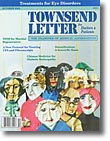


October 2002
Mistletoe
Extracts & Cancer Therapy
reviews
by Beatrice Trum Hunter

Iscador
by
Robert W. Gorter, MD
In Iscador, Dr. Gorter describes mistletoe preparations used in anthroposophically extended cancer treatment. The white-berried mistletoe, Viscum album, was used as a medicinal plant in cancer by Rudolf Steiner, the founder of anthroposophy, in the early 1900s. He found that mistletoe supports the body's functions, which are vital for healing processes, and therefore can strengthen the body's defense against cancer. By the 1920s, Ita Wegman, a Dutch physician, introduced the mistletoe preparation, Iscador, into cancer treatment. Since then, clinical experience with mistletoe preparations have yielded beneficial results. The book, Iscador, provides information about the botanical activity of the plant, its processing into medicinal preparations, and its use in clinical applications.
Although four species of mistletoe grow in Europe, only the white-berried ones are used for cancer treatment. They are harvested from several deciduous hardwood trees (oak, apple, and elm), and from coniferous softwood trees (pine and fir). The apple- and pine-grown mistletoe comes from France; and the fir-grown mistletoe, from Switzerland. The apple- and pine-grown ones are common; the elm- and oak-grown ones, less common.
Mistletoe contains, among other constituents, two groups of toxins: viscotoxins and lectins. The molecular and pharmacological actions of viscotoxins are closely related to those of snake venom. They have cytolytic action (i.e. they dissolve cancer cells). The lectins are related to castor-oil plant lectins. The mistletoe lectins have cytostatic properties (i.e. they inhihit the growth of cancer cells).
After careful processing, the extracted viscotoxins and lectins are fermented by the addition of Lactobacilli to control the process. The lactic acid reduces the pH. After two or three days, a balance is achieved between the constituents of the plant material and the liquid medium. The lactic acid preserves the extract. Solid and insoluble plant residues are expressed out of the fermented mistletoe. The extracts are sealed in ampules, and used for subcutaneous injections, at regular intervals, usually in the abdomen or thigh. The extracts are obtainable by prescription.
The biological activity of mistletoe extracts can be demonstrated in the test tube. The cells multiply in a nutrient solution. Growth of a human leukemic cell line (Molt H) in a cell culture is stopped by mistletoe extract. Cytostasis occurs because the extract prevents intracellular protein synthesis and cell division. Microscopic examination shows a marked reduction of cell numbers. Animal sarcoma cells (Yoshida) are destroyed by mistletoe extract activity on the cell membrance, and causes cytolysis. Microscopic examination shows that the cells are dead.
The principles of mistletoe therapy were developed by the scientific investigations of Rudolf Steiner. He found that mistletoe constituents stimulate inflammatory processes in the body to combat tumor development. The aim of anthroposophical medicine, according to Dr. Gorter, is "to activate the individual configurative vital forces of patients in the tumor area, as these forces are no longer active enough in cancer patients.”
Dr. Gorter, born in Holland, trained in medicine in Amsterdam, and at the anthroposophical Lukas Clinic in Switzerland. He has practiced medicine with distinction for more than a quarter of a century, and is University Lecturer at the European Institute for Oncological and Immunological Research in Berlin.
Iscador is a good introduction to mistletoe therapy. The book is clearly written, and profusely illustrated. Videos on mistletoe treatment, references, and addresses of anthroposophically-oriented clinics in Europe are listed. Further information on mistletoe treatment and preparations are available at http://www.hiscia.ch/literatur.asp
Iscador
by
Robert W. Gorter, MD
Quality paperback, color illustrations, sources, references, 82 pages,
1998. Order from FONMUNA, P.O. Box 257, Congers, New York 10920 USA; 914-268-2764,
$14 (includes postage)
Iscador
by
Christine Murphy, editor
This book is a collection of articles, contributed by various writers. Unfortunately, the book is long on many topics allied to mistletoe therapy, such as how cancer arises, self-help in cancer treatment, painting therapy for cancer patients, etc.; but short on the actual subject of mistletoe. The most valuable portion of the book is a section on the clinical applications of mistletoe with cancer, written by Richard Wagner, MD. The resource list may be helpful, because it lists physicians in the United States who use mistletoe. There are also lists of groups using anthroposophical therapies, hospitals and clinics in Germany and Switzerland, books, articles, and videos that might be useful for patients as well as professionals.
Christine Murphy edits Lilipoh, a quarterly journal specializing in the anthroposophical approach to health, homeopathy, and naturopathic medicine. She authored Practical Home Care Medicine.
![]()
Iscador
by
Christine Murphy, editor
Lantern
Books, 1 Union Sq. W, Suite 201, New York, New York 10003 USA.
Quality
paperback, b/w drawings, resources, glossary, 197 pages, 2001, $20

Search
our pre-2001 archives
for further information. Older issues of the printed magazine are also
indexed for your convenience.
1983-2001
indices ;
1999-Jan. 2003 indices
Once you find the magazines you'd like to order, please use our
convenient form, e-mail subscriptions@townsendletter.com,
or call 360.385.6021 (PST).
All rights reserved.
Web site by Sandy Hershelman Designs